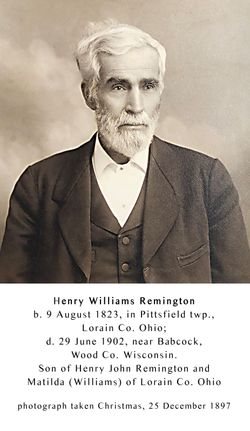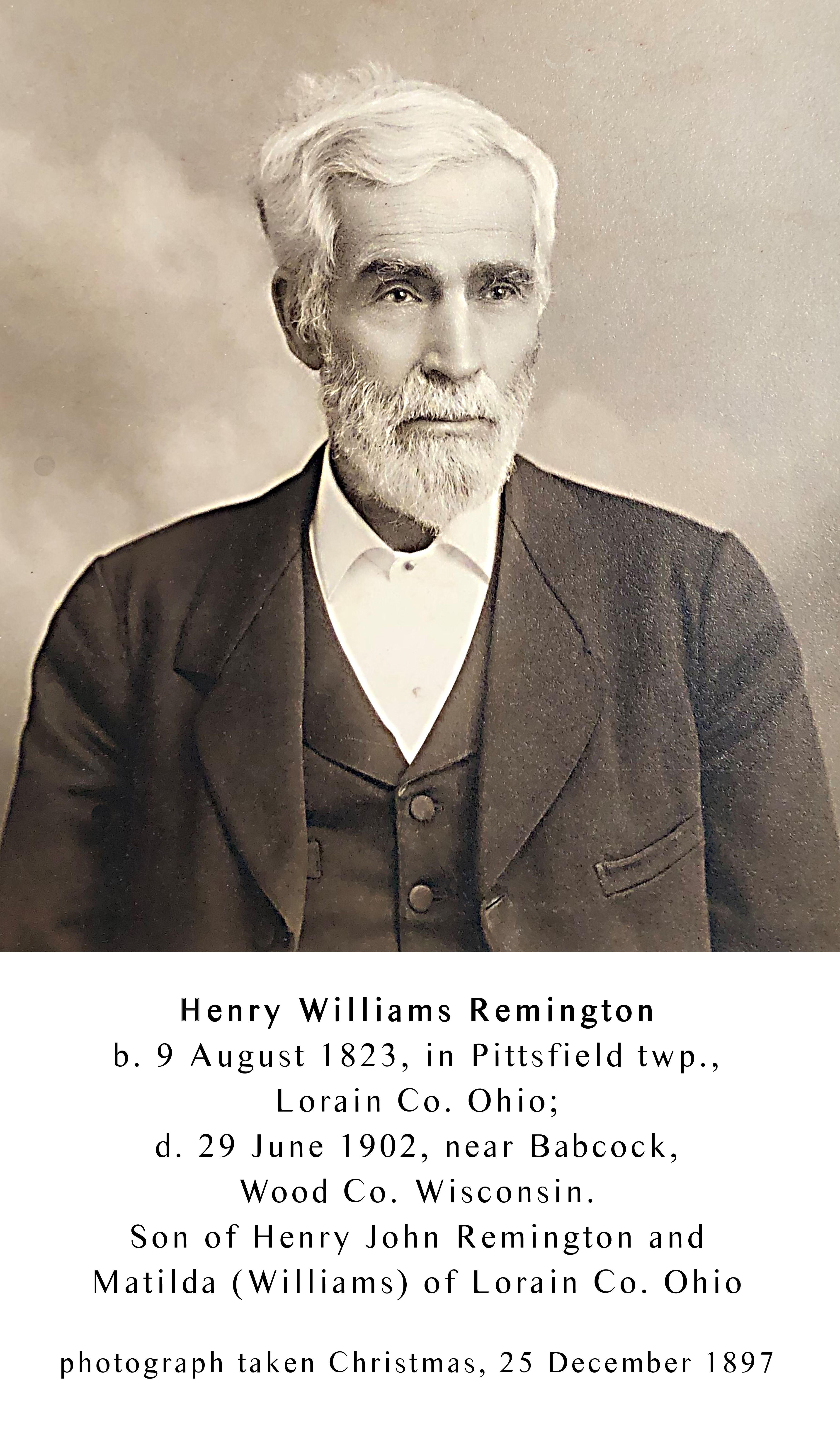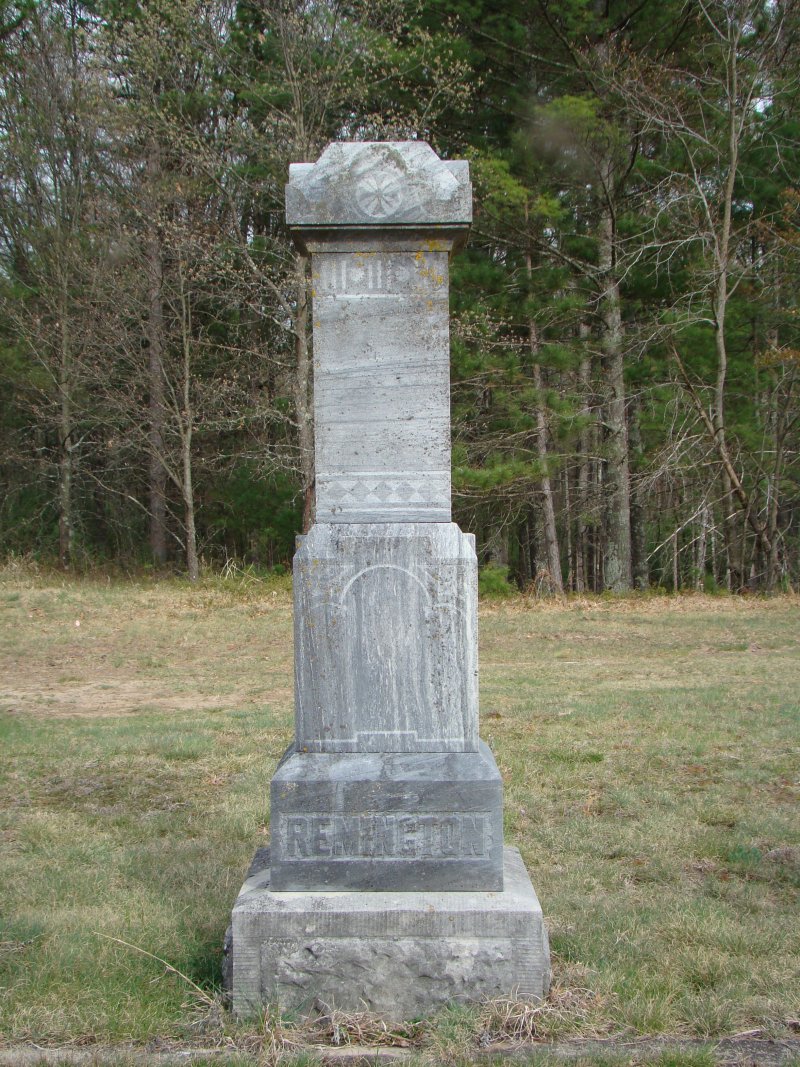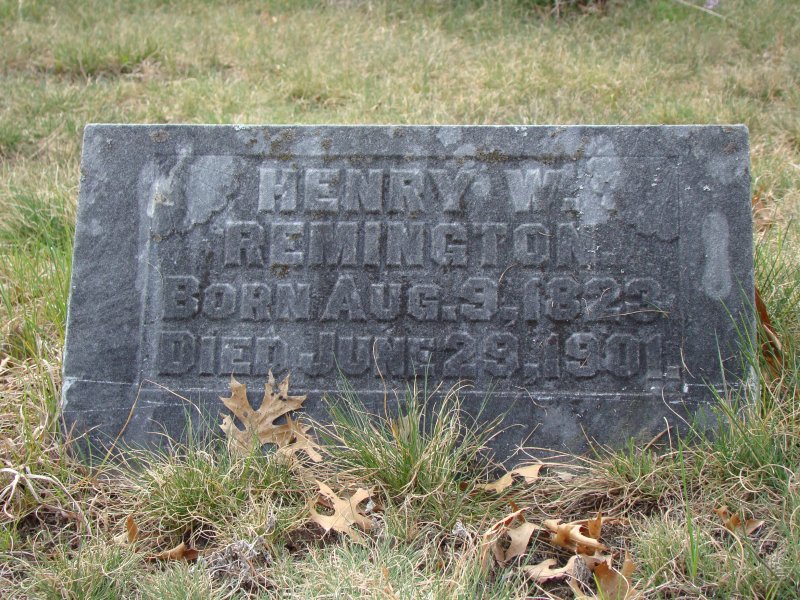in "Town No. 4," now Pittsfield, Lorain County, Ohio, Aug. 9, 1823. His parents were from New England, the paternal branch being domiciled at Turkey Hill, Connecticut. Mr. Remington's mother, whose maiden name was Matilda Williams, was a descendant of a Rhode Island family, her father, however, having moved to Berkshire County, Mass., where she and her husband were married.
In January, 1822, they set out for Ohio, which was then almost regarded as a frontier territory, and stopped when they reached Lorain County, in the month of March following. Their son H. W., was the first white child born in "Town No. 4." In 1837 they again moved west settling in Steuben County, Indiana. But the climate, water or other local conditions proving very unhealthy, they returned three years later to Lorain County, Ohio, settling in the town of Amherst. There in 1841 H. W. Remington began teaching school, and some time afterward went into the county treasurer's office as assistant. While there he studied surveying
with John Sherman. But the family becoming involved in financial difficulties, he bought some goods on time and procuring a wagon, set out as a peddler to try to repair their fortunes. In Illinois he found himself in the midst of the Mormon War, and was at different times held a captive by both sides. His trip, however, was financially successful, and he was not only able to help his parents, but ventured on matrimony, and bought 150 acres of land, which he started to clear. Mr. Remington, however, was a man of many misfortunes. He lost his property at the end of a year, and then giving all the money he had to his father to be applied to the support of his wife and child, he went to Medina, Ohio, to study law. Having completed the course in 1848, he came to Wisconsin, and
was admitted to the bar at Madison. There he met with good success in his profession, but was forced to abandon it on account of ill health, and for some years thereafter gave his attention to railroad construction work, and city improvements. In these things he met with financial success, but in 1857 he was overwhelmed by a perfect avalanche of misfortunes, as, during that year his wife went insane from the effects of typhoid fever, a large amount of property he owned was destroyed by fire, a bank failure took $16,000 of his money, and the Madison & Watertown Railroad, in which he was interested, collapsed, leaving him completely
stranded, with three little children to care for. Fourteen years of varied
discouragements followed, but in 1871 he set to work to make his dream of the Wisconsin Valley Railroad a reality. He enlisted the support of Judge L. P. Powers, of Grand Rapids, John Rablin, Seth Rivers, R. C. Lyon and John Edwards. Against severe opposition the road was put into operation two years later. Shortly after his misfortunes Mr.Remington had moved into the cranberry marshes in the southwestern portion of Wood County, believing in their future value, and had made his homethere, isolated from all appearance of civilization; but with the passing of the years, and particularly after the opening of the Wisconsin Valley Railroad, a settlement grew up about him, and the surrounding township was named after him. He was a leading figure in the community, and was repeatedly elected chairman of the township and county boards. Though he has long since passed away, his name is one of the most familiar in the annals of Wood County.
"History of Wood County, Wisconsin" compiled by George O. Jones, Norman S. McVean and others : illustrated. H. C. Cooper, Jr. & Co.,
1923 Page 654.
in "Town No. 4," now Pittsfield, Lorain County, Ohio, Aug. 9, 1823. His parents were from New England, the paternal branch being domiciled at Turkey Hill, Connecticut. Mr. Remington's mother, whose maiden name was Matilda Williams, was a descendant of a Rhode Island family, her father, however, having moved to Berkshire County, Mass., where she and her husband were married.
In January, 1822, they set out for Ohio, which was then almost regarded as a frontier territory, and stopped when they reached Lorain County, in the month of March following. Their son H. W., was the first white child born in "Town No. 4." In 1837 they again moved west settling in Steuben County, Indiana. But the climate, water or other local conditions proving very unhealthy, they returned three years later to Lorain County, Ohio, settling in the town of Amherst. There in 1841 H. W. Remington began teaching school, and some time afterward went into the county treasurer's office as assistant. While there he studied surveying
with John Sherman. But the family becoming involved in financial difficulties, he bought some goods on time and procuring a wagon, set out as a peddler to try to repair their fortunes. In Illinois he found himself in the midst of the Mormon War, and was at different times held a captive by both sides. His trip, however, was financially successful, and he was not only able to help his parents, but ventured on matrimony, and bought 150 acres of land, which he started to clear. Mr. Remington, however, was a man of many misfortunes. He lost his property at the end of a year, and then giving all the money he had to his father to be applied to the support of his wife and child, he went to Medina, Ohio, to study law. Having completed the course in 1848, he came to Wisconsin, and
was admitted to the bar at Madison. There he met with good success in his profession, but was forced to abandon it on account of ill health, and for some years thereafter gave his attention to railroad construction work, and city improvements. In these things he met with financial success, but in 1857 he was overwhelmed by a perfect avalanche of misfortunes, as, during that year his wife went insane from the effects of typhoid fever, a large amount of property he owned was destroyed by fire, a bank failure took $16,000 of his money, and the Madison & Watertown Railroad, in which he was interested, collapsed, leaving him completely
stranded, with three little children to care for. Fourteen years of varied
discouragements followed, but in 1871 he set to work to make his dream of the Wisconsin Valley Railroad a reality. He enlisted the support of Judge L. P. Powers, of Grand Rapids, John Rablin, Seth Rivers, R. C. Lyon and John Edwards. Against severe opposition the road was put into operation two years later. Shortly after his misfortunes Mr.Remington had moved into the cranberry marshes in the southwestern portion of Wood County, believing in their future value, and had made his homethere, isolated from all appearance of civilization; but with the passing of the years, and particularly after the opening of the Wisconsin Valley Railroad, a settlement grew up about him, and the surrounding township was named after him. He was a leading figure in the community, and was repeatedly elected chairman of the township and county boards. Though he has long since passed away, his name is one of the most familiar in the annals of Wood County.
"History of Wood County, Wisconsin" compiled by George O. Jones, Norman S. McVean and others : illustrated. H. C. Cooper, Jr. & Co.,
1923 Page 654.
Family Members
Sponsored by Ancestry
Advertisement
Advertisement












